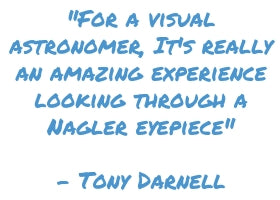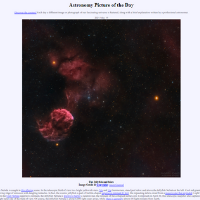Optical Innovation with Tele Vue


The technologies and the way in which astronomy has evolved over the years has really made for some amazing experiences. This podcast Provides information on two different levels both on a beginner level for someone who’s never looked through a telescope before, maybe help navigate the bewildering choices and concepts in the world of telescopes and eyepieces and also give some information for advanced amateurs who may be looking for more advanced information for their observing. Tele Vue comes from a long history of Optical design. .
Nagler eyepiece concept, this was to be an eyepiece that had a much larger apparent field of view than was commercial available with far better image correction across that field than any other eyepiece, regardless of design. It was going to be comfortable to use with longer eye relief. This turned into a big, complex and expensive project which he decided to pursue. As the eyepiece took form, he realized it was going to be something that he didn’t know that was going to be commercially successful because it was going to be so much larger and more expensive than anything else on the market


Ethos: created a revolution in eyepieces, all over again. Went from 82 to 100 degrees. Incorporated everything we knew about eyepieces and incorporated it into this eyepiece. Had to be wide field, sharp and high contrast- but as perfect distortion correction across 100 degrees and had to have enough long eye relief for comfort.
what is it about this eyepiece that makes people say wow?. It was a nexus of the apparent field of view- very large. The fact that you can use a higher mag. For a given true field size because of that app. FOV. When you use a higher mag. The sky background gets darker and fainter stars start to appear. You’re seeing that same field of view with higher contrast than at a lower power. It was a nexus of those 3 things that he came up with a factor- the majesty factor.
Fast Telescope- telescope with a short focal length, gives a wide field of view. For example: fast system: paper towel tube. Slow system: straw. You can consider the telescope objective, whether is a refractor reflex. It’s like a camera lens. When we talk about fast or slow it’s like Like an f-ratio in a camera lense. Focal length/aperture gives you f #. The way it relates to eyepieces the faster the f number the more demand it places on the quality of the design of the eyepiece. When it comes down to the true field of view, it’s actually the focal length of the scope as it relates to the field stop of the eyepiece. With any telescope focal length, you can create any f-ration given enough aperture, but if you want to take a long focal and make it a fast telescope you need a very large aperture. People have to think regarding the f ratio of the telescope that visually it really doesn’t have any meaning and the only factor that it will have for you is in the demand is places on the eyepiece
Tele Vue Telescopes and their design
Tele Vue’s trade off to color correction- for short focal length/wide field. He knew he could make what he wanted was the ultimate multipurpose telescope. 5” f4 refractor- real OG; only be used for low power/wide field views. If you crank up the mag. On a brighter object like Jupiter, you’re going to see a lot of “purple fringe” to it. But a sneaky trick was used, he installed an iris diaphragm like a camera lens has, which allows you to stop the aperture of the telescope down, thereby slowing it down, improving the color correction. Lose resolution potential because you’re slowing it down, but you could take that f4 system and stop it to f/16 wit the iris diaphragm. You could vary it anywhere in between to where you could get the best balance for any particular view, which set him on the path of these fast refractors. Took the Petzval concept. New NP 101 IS and NP 127 IS about as far as you can go as far as the performance of these scopes. These are Flat field instruments for astrophotography, fast instruments for Astophotography, their short focal length for wide fields, they give wonderful low-power wide field views up to 5 degrees of true field. Yet their high-power performance is that of unheard-of performance compared to old long focal length refractors. Get absolutely pristine color correction at the highest magnifications, as well as the benefit of the low power wide field. NP design you don’t need that extra correction. If you see any telescope (doublet, triplet etc.) that only has lenses in the front, then you know that’s not a flat field design. If the telescope is slow, the field curvature is going to be much less than if the telescope is a fast design. All these short focal lengths fast doublets and triplets really need a field flattener to do imaging. -flat field: where all the light comes to a focus, that needs to be a plane for everything to be in focus. - curved focal: plane won’t have the edges in focus, while the center is. That’s important for photography and is better for visual as well. The shorter the focal length, the great the Petzval radius (field curvature). If you’re using a wide field, low power eyepiece it’s very possible that you won’t see the center and edge of field in same focus. You can refocus the telescope to compensate if you’re vision is bad. If no, your eye will automatically refocus.
Like what you listened to? Hate what you've heard? Let us know in the comments below!











